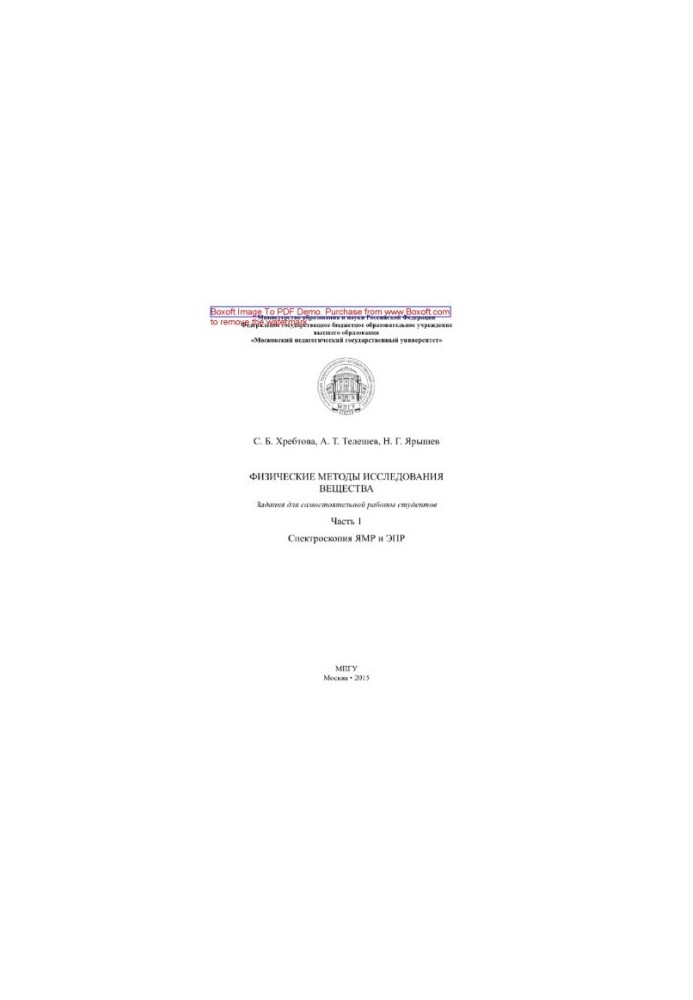Physical methods of studying matter. Tasks for independent work of students. Part 1. Spectroscopy of NMR and EPR. Study
 Instant download
Instant download
after payment (24/7)
 Wide range of formats
Wide range of formats
(for all gadgets)
 Full book
Full book
(including for Apple and Android)
Physical Methods of Substance Research . Tasks for independent work of students . Part 1. Spectroscopy of NMR and EPR" is an indispensable educational resource created by a team of authors, which is aimed at students and graduate students studying physics and related sciences. This publication is a deep dive into the world of spectroscopy, covering both theoretical foundations and practical tasks, making it an ideal assistant for those who seek a deeper understanding of physical methods of studying matter. The book begins with an introduction to the basic concepts of nuclear magnetic resonance (NMR) and electronic paramagnetic resonance (EPR), which allows readers to realize the importance of these methods in modern scientific research. NMR and EPR spectroscopy is a powerful tool for studying the structure and dynamics of molecules, as well as for analyzing various substances, from simple organic compounds to complex biomolecules. The authors strive not only to explain the theory, but also to provide readers with the opportunity to apply the knowledge gained in practice through tasks that contribute to the development of analytical thinking and problem solving skills. This book will be especially useful for students of physical, mathematical and chemical specialties, as well as for those who are interested in modern methods of substance analysis. It is suitable for both beginners and more experienced researchers who want to deepen their knowledge in the field of spectroscopy. If you study in the Faculty of Physics, Chemistry or Biology, or just want to expand your horizons in scientific research, this publication will become your reliable companion. The topics raised in the book cover not only the technical aspects of NMR and EPR, but also their application in various fields of science, such as chemistry, biology, and materials science. The book focuses on the importance of experimental data and their interpretation, which makes it relevant for students seeking practical application of theoretical knowledge. In addition, she emphasizes the need for critical thinking and attentiveness in conducting experiments, which is a key aspect of scientific work. The style of the authors is clear and accessible, which allows even complex concepts to be explained in simple language. They use a lot of examples and illustrations to make the material more visual and understandable. This approach helps readers not only learn information, but also become interested in the topic, which is especially important for students who may have difficulty understanding complex physical concepts. The book Physical Methods of Substance Research is the first part of a more extensive tutorial, which suggests that there will be subsequent volumes that will cover other aspects of physics and research methods. This creates an opportunity for readers to continue their learning and deepen their knowledge in other areas, such as optics or X-ray spectroscopy. If you are looking for a textbook that not only teaches but also inspires research activities, "Physical Methods of Substance Research. Tasks for independent work of students . Part 1. NMR and EPR Spectroscopy" is exactly what you need. Do not miss the chance to enrich your knowledge and skills in the field of physics and spectroscopy, discovering a world full of fascinating discoveries and scientific mysteries.
LF/167394404/R
Data sheet
- Name of the Author
- Collective of authors
- Language
- Russian
- ISBN
- 9785426303294
- Release date
- 2017



























